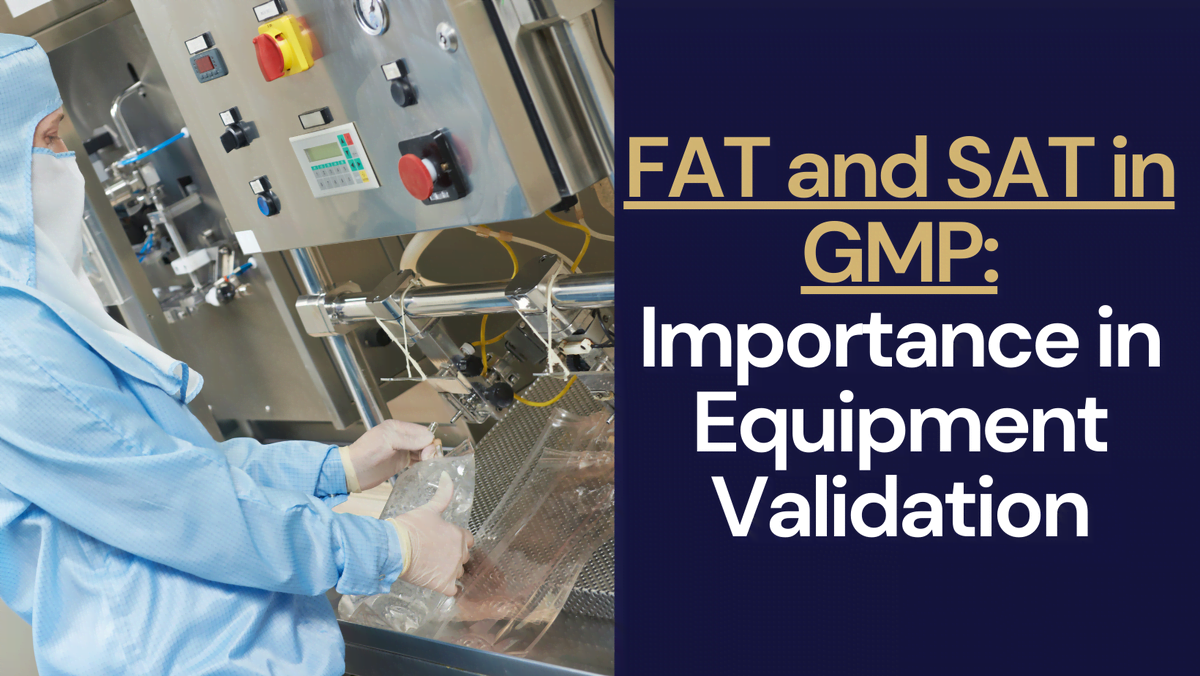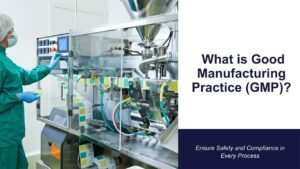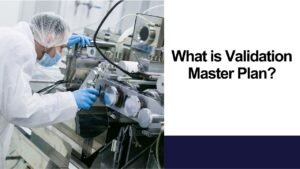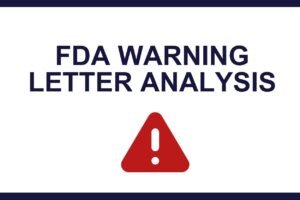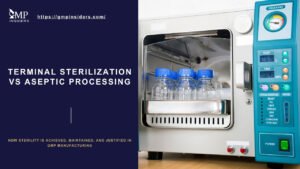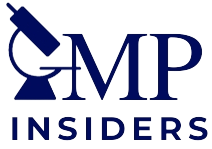Factory Acceptance Testing (FAT) and Site Acceptance Testing (SAT) are crucial in ensuring the quality, compliance, and performance of equipment and systems in GMP facilities.
While both FAT and SAT serve the purpose of verifying the functionality and specifications of the equipment, there are distinct differences between the two processes. In this article, we will explore the importance of FAT and SAT in the validation of equipment and systems.
FAT vs SAT: Overview
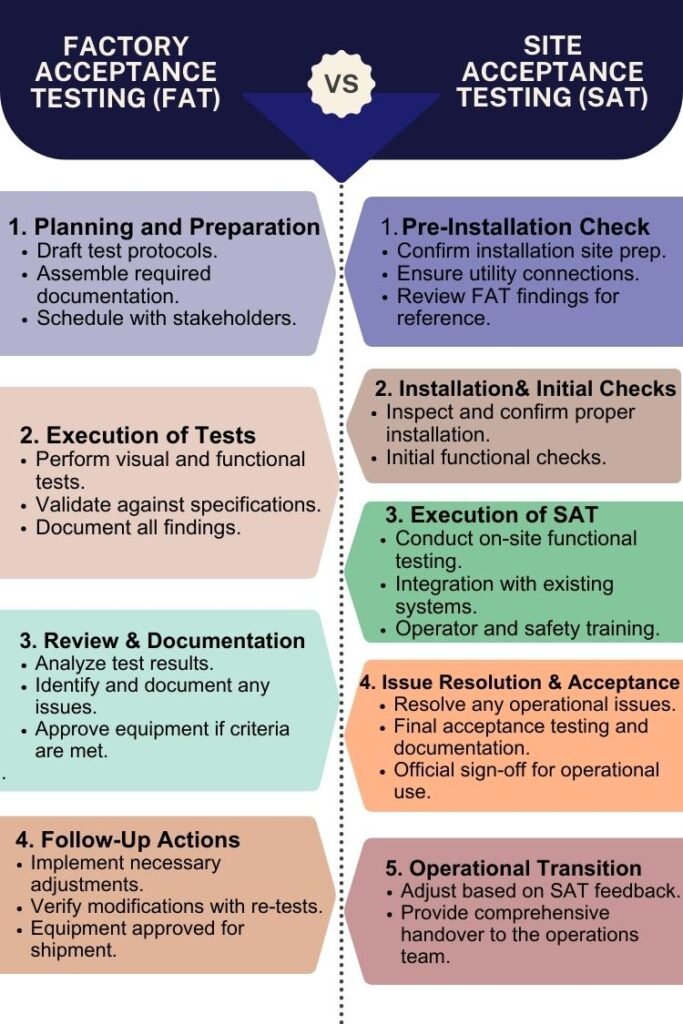
Proper validation of equipment and systems is essential to ensure compliance with regulatory requirements, maintain product quality, and protect patient safety. Two critical stages in the validation process are Factory Acceptance Testing (FAT) and Site Acceptance Testing (SAT).
Factory Acceptance Testing (FAT) is conducted at the manufacturer’s site before the equipment or system is shipped to the client’s facility. The main goal is to verify that the system is fully functional and meets all specified requirements as agreed upon.
Site Acceptance Testing (SAT) takes place at the client’s site after the equipment or system has been installed but before it is officially put into operation. The purpose of SAT is to ensure that the system not only functions according to its specifications but also operates correctly within its intended environment.
Both FAT and SAT are vital steps in the validation process and contribute to the overall success of a project.
What is Factory Acceptance Testing (FAT)?
Factory Acceptance Test (FAT) is a critical step in the validation process that follows the qualification stage of design qualification (DQ). It involves a series of tests performed on equipment at the system manufacturer’s site to verify that the vendor has fulfilled responsibilities and met regulatory and client requirements.
The primary objectives of conducting FAT include:
- Convincing customers that they are purchasing high-quality equipment/systems.
- Ensuring that every component and control works according to its functionality.
- Saving time, effort, and money by identifying and resolving any issues at the manufacturer’s site.
- Evaluating if the equipment operates following design specifications.
Benefits of FAT
FAT offers several benefits to both the vendor and the customer. These include:
- Assurance of quality: FAT allows the customer to witness and evaluate the equipment’s performance, ensuring that it meets their expectations and requirements.
- Time and cost savings: Identifying and resolving any issues or discrepancies during FAT can save significant time and costs compared to addressing them during on-site installation or commissioning.
- Evaluation of functionality: FAT verifies that every component and control of the equipment or system works according to its functionality and design specifications.
- Compliance with regulatory requirements: FAT ensures that the equipment adheres to GMP regulatory standards and guidelines, minimizing the risk of non-compliance.
FAT Process and Documentation
The FAT process involves a series of tests and inspections carried out by the vendor at their facility. The specific tests and procedures may vary depending on the equipment or system being tested and the customer’s requirements. However, some common elements of the FAT process include:
- Inspection: The equipment is visually inspected to ensure it conforms to the final design and drawing specifications.
- Functional testing: The equipment’s functionality is tested to verify that it operates as intended and meets the specified requirements.
- Documentation review: The vendor reviews and provides documentation related to the equipment, including maintenance and user manuals, technical drawings, calibration certificates, and data sheets.
- Test cases and procedures: The FAT should include a clear description of test cases, procedures, and associated test data to ensure comprehensive testing.
- Acceptance criteria: The customer and vendor agree upon acceptance criteria that determine whether the equipment has passed the FAT.
The documentation generated during FAT serves as a reference for the installation qualification. It includes the FAT protocol, maintenance, and user manuals, recommended spare parts list, certificates of compliance, technical drawings, and instrument calibration certificates.
FAT Tests
Factory Acceptance Testing typically includes the following tests:
- Inspection and verification of the equipment’s conformity to design and drawing specifications.
- Verification of contractual obligations and compliance with customer requirements.
- Testing the equipment’s functionality, including control systems, components, and interlocks.
- Verification of critical instrument’s calibration and accuracy.
- Testing software and hardware functionality, including input/output verification and control panel operation.
- Verification of alarms, interlocks, access levels, recipe management, and control panel functionality.
These tests aim to ensure that every component and control of the equipment operates according to its functionality and design specifications.
What is Site Acceptance Testing (SAT)?
Site Acceptance Testing (SAT) is conducted at the customer’s site after the equipment or system has been delivered and installed, according to Annex 15. The purpose of SAT is to verify that the equipment functions properly in its working environment and interfaces correctly with other systems and peripherals.
The objective of SAT is to ensure that the equipment or system has been installed correctly and meets the customer’s specific requirements and specifications. It provides documented evidence that the equipment has not been affected by transportation or installation and is ready for operation.
Importance of SAT in Commissioning and Qualification
SAT holds significant importance in the commissioning and qualification of equipment and systems. It serves as the final test for equipment, ensuring that it is installed correctly and interfaces properly with other systems in its working environment. SAT also provides an opportunity to identify and address any issues or discrepancies before the equipment is fully operational.
SAT is a continuous process where the equipment is tested for a period of 1-2 weeks without any problems. If any issues arise during SAT, the involved parties must come together to discuss and resolve them. Successful SAT completion leads to the start-up of the plant, ensuring that the equipment meets the required functionality and performance standards.
SAT Process and Documentation
SAT involves a series of tests and inspections performed at the customer’s site to validate the proper installation and functionality of the equipment or system. The specific tests and procedures may vary depending on the nature of the equipment and the customer’s requirements. Some common elements of the SAT process include:
- Visual inspection: The equipment is visually inspected to ensure that it has been installed correctly and that all components are in place.
- Functional testing: The equipment’s functionality is tested to verify that it operates as intended and interfaces correctly with other systems and peripherals.
- Interlocks and safety devices: The functionality of interlocks and safety devices is checked to ensure proper operation and compliance with safety regulations.
- Operator’s training: The customer’s operators are trained on how to use the equipment effectively and safely.
The documentation generated during SAT includes reports, checklists, and records of the testing activities and results. It serves as a reference for troubleshooting, maintenance, and future performance testing of the equipment or system.
SAT Tests
Site Acceptance Testing includes the following tests:
- Visual inspection of the equipment’s installation and components.
- Verification of the equipment’s internal pressure, ventilation, and utilities functionality.
- Testing the functionality and interlocks of the equipment, including mechanical and software components.
- Testing the dispensing systems, if applicable.
- Verification of safety devices, interlocks, and alarms.
- Operator training to ensure familiarity with equipment operation.
SAT tests focus on validating the proper installation, functionality, and integration of the equipment in its working environment.
Key Differences between FAT and SAT
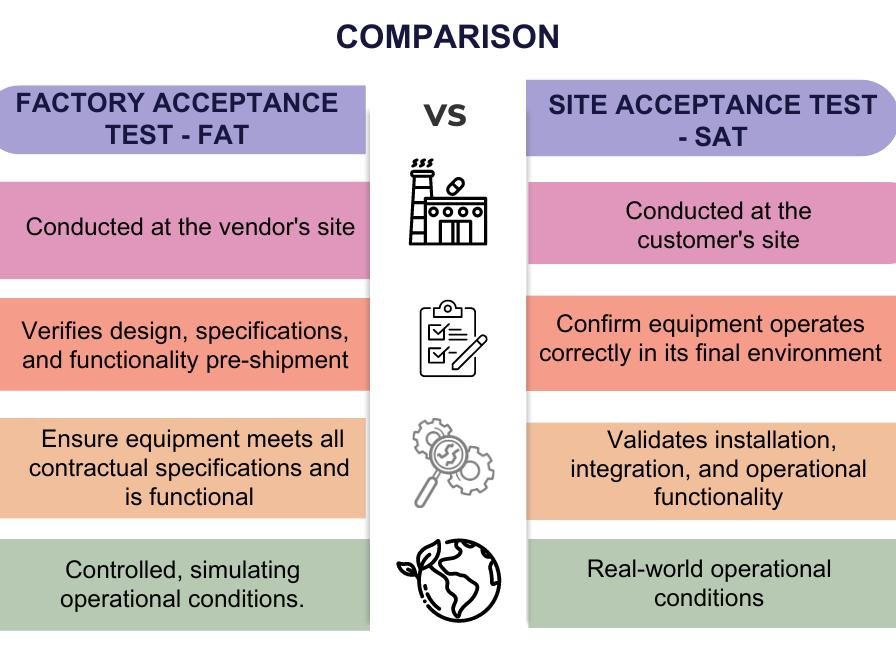
While FAT and SAT share the common goal of verifying equipment functionality, there are several key differences between the two processes. These differences include the location of testing, environmental conditions, and documentation complexity.
Location
The primary difference between FAT and SAT is the location where the testing takes place. FAT is conducted at the vendor’s site, typically in a controlled environment, while SAT is performed at the customer’s site, where the equipment will be operated.
During FAT, the vendor has control over the testing environment, allowing them to simulate various conditions and ensure that the equipment functions as intended. In contrast, SAT tests the equipment in its actual working environment, including real utilities such as compressed air or steam.
Environmental Conditions
Another significant difference between FAT and SAT is the environmental conditions in which the testing occurs. The vendor’s site where FAT is conducted may have different temperature and humidity levels compared to the customer’s site.
The environmental conditions during FAT may not accurately reflect the conditions in which the equipment will be operated. SAT provides an opportunity to test the equipment under the actual environmental conditions, ensuring that it performs optimally.
Documentation Complexity
FAT and SAT also differ in terms of documentation complexity. FAT documentation tends to be more detailed and comprehensive, as it is conducted at the vendor’s site and involves extensive testing and verification of the equipment’s functionality.
In contrast, SAT documentation is generally simpler and focuses on verifying the proper installation and functionality of the equipment in its working environment. The documentation generated during SAT serves as a reference for troubleshooting, maintenance, and future performance testing.
Scope of Testing
The scope of testing is another key difference between FAT and SAT. FAT primarily focuses on the equipment/system itself and its functionality, ensuring that it meets the required specifications and operates as intended. It includes tests such as calibration verification, software and hardware functionality, input/output verification, and control panel verification.
SAT, on the other hand, expands the scope of testing to include the interface of the equipment/system with other systems, peripherals, and utilities. It verifies the proper installation, functionality, and performance of the equipment/system in its working environment. SAT includes tests such as utility functionality and configuration verification, interlock verification, and operator training.
Importance of FAT and SAT
FAT and SAT are essential steps in the validation process of equipment and systems in GMP. They play a crucial role in ensuring equipment quality, compliance with regulatory requirements, and optimal performance. The importance of FAT and SAT can be summarized as follows:
Compliance with User Requirements
FAT and SAT ensure that the equipment/system meets the user requirements as specified in the Validation Master Plan (VMP) and User Requirements Specification (URS). By conducting FAT and SAT, companies can verify that the equipment/system functions as intended and complies with the required specifications, regulatory standards, and industry best practices.
SEE MORE: Validation Master Plan
Ensuring Equipment Quality and Compliance
FAT and SAT are key elements in demonstrating equipment quality, efficiency, compliance, and performance. By conducting these tests, manufacturers and customers can verify that the equipment meets the specified requirements, functions correctly, and complies with regulatory standards.
FAT allows customers to assess the quality and performance of the equipment before installation, ensuring that it meets their expectations. SAT verifies that the equipment functions properly in its intended environment and interfaces correctly with other systems.
Time and Cost Savings
FAT and SAT can significantly contribute to time and cost savings in the validation process. By identifying and resolving any issues or discrepancies during FAT, manufacturers, and customers can prevent costly delays and rework during on-site installation and commissioning.
FAT provides an opportunity to address any issues or modifications before the equipment is shipped, saving time and costs associated with resolving problems at the customer’s site. SAT allows for final verification and adjustments, ensuring a smooth transition to the operational phase.
Qualification Strategy: Leveraging Approach
FAT and SAT also play a crucial role in the qualification strategy by leveraging the activities and documentation performed during the testing stages. Leveraging involves utilizing properly documented activities carried out during FAT and SAT to support qualification (Installation Qualification – IQ and Operational Qualification – OQ) processes. This approach reduces unnecessary repetitions and saves qualification time.
RELATED: Qualification vs Validation
By leveraging FAT and SAT activities, companies can streamline the qualification process, ensuring that the execution follows good documentation practices, specific testing scopes, and predefined raw data requirements. This approach allows for efficient qualification tests and reduces the overall time and resources required for qualification.
Best Practices for FAT and SAT
To ensure successful FAT and SAT, the following best practices should be followed:
Reliable Personnel and Clear Testing Strategies
Having reliable personnel on both the vendor and customer sides is crucial for effective FAT and SAT. Skilled individuals with expertise in equipment testing, validation, and compliance should be involved in the process.
Clear testing strategies should be developed and agreed upon by all stakeholders. The strategies should outline the testing objectives, scope, procedures, acceptance criteria, and documentation requirements.
Pro Tips:
- Develop Comprehensive Testing Strategies: Create detailed testing strategies that include step-by-step procedures, timelines, and specific criteria for success. Use flowcharts or diagrams to visualize testing sequences and dependencies.
- Practice Risk Assessment: Incorporate risk assessment into your testing strategies to anticipate and mitigate potential issues. This proactive approach helps in ensuring smoother FAT and SAT processes.
Professional User Requirements Specification (URS)
A well-defined User Requirements Specification (URS) is essential for both FAT and SAT. The URS should clearly outline the customer’s requirements, specifications, and expectations for the equipment.
The URS serves as the foundation for the FAT and SAT, ensuring that the equipment is tested and validated against the agreed-upon criteria.
Pro Tips:
- Utilize Clear and Measurable Criteria: Make sure the URS contains clear, measurable, and testable criteria. This facilitates effective testing and validation during FAT and SAT, as there is a clear benchmark for success.
- Align URS with Industry Standards: Ensure that the URS aligns with applicable industry standards and regulations. This not only ensures compliance but also enhances the reliability and safety of the equipment.
Read more about User Requirement Specification and download free template in our article.
Collaboration and Communication
Effective collaboration and communication between the vendor and customer are critical for successful FAT and SAT. Regular communication channels should be established to discuss progress, address any issues or concerns, and ensure alignment between the vendor and customer.
Collaboration should extend to reviewing and approving documentation, test protocols, and any modifications or adjustments identified during FAT and SAT.
Pro Tips:
- Establish Clear Communication Channels: Set up dedicated communication channels such as regular meetings, progress reports, and real-time collaboration tools to facilitate effective communication between all parties involved.
- Document Communications: Keep a record of all communications, decisions, and agreed-upon changes. This documentation can be invaluable for resolving any disputes and for future reference.
Thorough Documentation and Review
Comprehensive documentation is crucial throughout FAT and SAT. This documentation should include detailed test protocols, results, observations, and any identified issues or non-compliance. Both the equipment/system supplier and the customer should review and approve the documentation to ensure that all requirements are met and any necessary modifications are addressed.
Pro Tips:
- Use Standardized Documentation Templates: Implement standardized templates for all documentation to ensure consistency and completeness. This aids in the clarity and efficiency of the review process.
Conduct Detailed Reviews: Allocate sufficient time for thorough reviews of all documentation, including test protocols, results, and compliance reports. Engage experts when necessary to ensure a comprehensive evaluation.
Common Findings During FAT and SAT
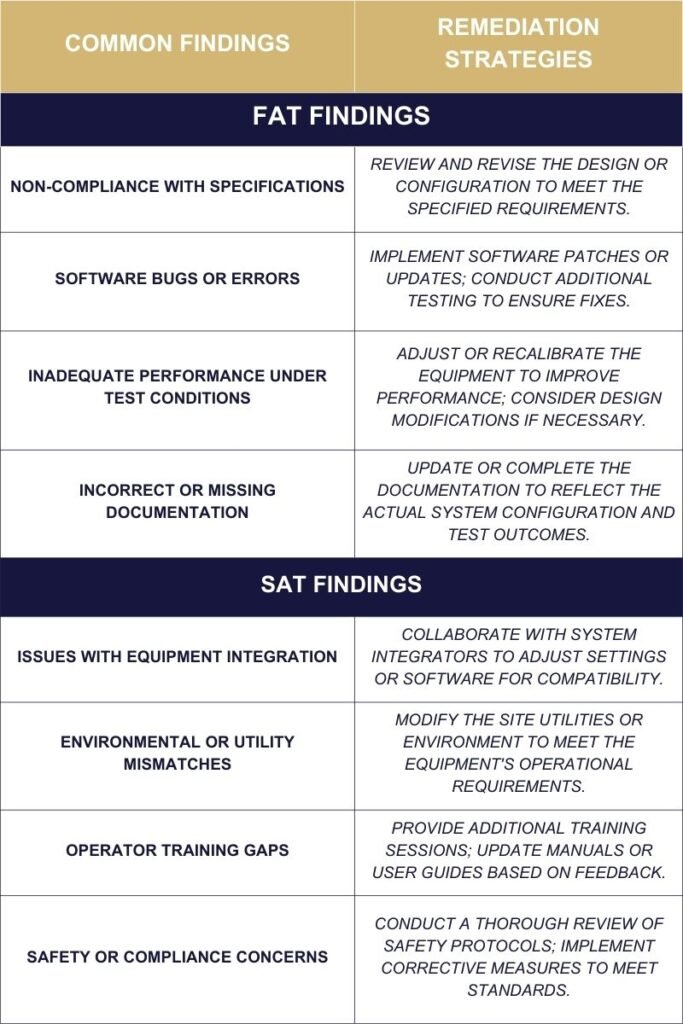
FAQ
Who Attends FAT?
Typically, representatives from the purchasing company, engineers, and quality assurance personnel attend FAT to witness the tests, validate the equipment against specifications, and ensure compliance with the purchase order.
How Are Identified Issues Resolved During FAT?
Issues that are identified during FAT are documented and discussed between the client and the manufacturer. Solutions are proposed and implemented to address these issues before the equipment is approved for shipment.
Why Is SAT Performed After FAT?
SAT complements FAT by ensuring the equipment not only meets specified requirements but also functions correctly in its actual working environment, taking into account the site-specific conditions and integration with other systems.
What Happens if Issues Are Found During SAT?
If issues are discovered during SAT, they are documented and addressed through collaboration between the client, manufacturers, and sometimes third-party engineers. Adjustments, recalibrations, or modifications may be required to ensure the equipment meets all operational specifications.
Can SAT Affect the Commissioning Schedule?
Yes, if significant issues are found during SAT that require extensive modifications or repairs, it can delay the commissioning schedule. It emphasizes the importance of thorough FAT and pre-SAT preparations to minimize potential delays.
FAT and SAT: Final Thoughts
Factory Acceptance Testing (FAT) and Site Acceptance Testing (SAT) are critical steps in the validation process of equipment and systems in GMP facilities. FAT ensures that the equipment meets specifications and functions as intended before it is shipped to the customer. SAT validates the proper installation, functionality, and integration of the equipment at the customer’s site.
Understanding the difference between FAT and SAT, their objectives, and the importance of each stage is crucial for ensuring equipment quality, compliance, and performance. By following current GMP practices, leveraging documentation, and maintaining effective collaboration, manufacturers and customers can streamline the validation process, save time and costs, and deliver reliable solutions.

